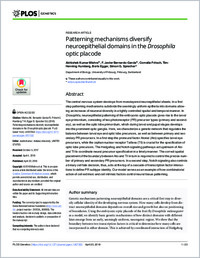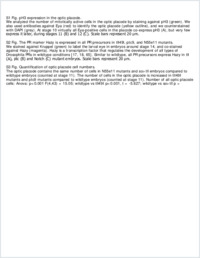Patterning mechanisms diversify neuroepithelial domains in the Drosophila optic placode
- Mishra, Abhishek Kumar Department of Biology, University of Fribourg, Switzerland
- Bernardo-Garcia, F. Javier Department of Biology, University of Fribourg, Switzerland
- Fritsch, Cornelia Department of Biology, University of Fribourg, Switzerland
- Humberg, Tim-Henning Department of Biology, University of Fribourg, Switzerland
- Egger, Boris Department of Biology, University of Fribourg, Switzerland
- Sprecher, Simon G. Department of Biology, University of Fribourg, Switzerland
-
20.04.2018
Published in:
- PLOS Genetics. - 2018, vol. 14, no. 4, p. e1007353
English
The central nervous system develops from monolayered neuroepithelial sheets. In a first step patterning mechanisms subdivide the seemingly uniform epithelia into domains allowing an increase of neuronal diversity in a tightly controlled spatial and temporal manner. In Drosophila, neuroepithelial patterning of the embryonic optic placode gives rise to the larval eye primordium, consisting of two photoreceptor (PR) precursor types (primary and secondary), as well as the optic lobe primordium, which during larval and pupal stages develops into the prominent optic ganglia. Here, we characterize a genetic network that regulates the balance between larval eye and optic lobe precursors, as well as between primary and secondary PR precursors. In a first step the proneural factor Atonal (Ato) specifies larval eye precursors, while the orphan nuclear receptor Tailless (Tll) is crucial for the specification of optic lobe precursors. The Hedgehog and Notch signaling pathways act upstream of Ato and Tll to coordinate neural precursor specification in a timely manner. The correct spatial placement of the boundary between Ato and Tll in turn is required to control the precise number of primary and secondary PR precursors. In a second step, Notch signaling also controls a binary cell fate decision, thus, acts at the top of a cascade of transcription factor interactions to define PR subtype identity. Our model serves as an example of how combinatorial action of cell extrinsic and cell intrinsic factors control neural tissue patterning.
- Faculty
- Faculté des sciences et de médecine
- Department
- Département de Biologie
- Language
-
- English
- Classification
- Biological sciences
- License
-
License undefined
- Identifiers
-
- RERO DOC 309436
- DOI 10.1371/journal.pgen.1007353
- Persistent URL
- https://folia.unifr.ch/unifr/documents/306988
Other files
Statistics
Document views: 85
File downloads:
- pdf: 175
- Supplementary material: 124

